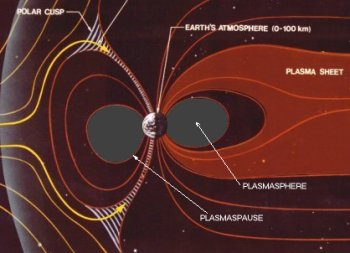 The plasmasphere is that region of dense, cold plasma surrounding the Earth. It is a part of the plasma-containing magnetosphere and is located just outside the upper ionosphere, extending to about 8000 to 25,000 miles into space. This donut-shaped volt of energy around our planet is the result of a process jumpstarted by the Sun’s ultraviolet light.
The plasmasphere is that region of dense, cold plasma surrounding the Earth. It is a part of the plasma-containing magnetosphere and is located just outside the upper ionosphere, extending to about 8000 to 25,000 miles into space. This donut-shaped volt of energy around our planet is the result of a process jumpstarted by the Sun’s ultraviolet light.
The upper portion of the Earth’s atmosphere is ionized with electrons liberated by the ultraviolet light of the Sun from neutral atmospheric particles, resulting into a gas now known as plasma, which is composed of both positive and negatively charged particles.
The positively charged particles are known as ions, while the negatively charged ones are termed electrons. Electrons are very low in mass, but tend to have high levels of energy. For this reason, the Earth’s gravity soon loses hold on them and they begin to gradually escape, leaving the ions to form a growing net of positive electric charge in the ionosphere while forming their own region of negatively charged space right above it. This negatively charged space will then keep the wayward electrons from moving any further from the Earth’s atmosphere.
The electrons retain their energy, and eventually attract the remaining lighter ions of hydrogen, helium and oxygen to leave the ionosphere as well. These camaraderie of escaping particles will then build up until a balance is achieved wherein there is as much plasma that flows into the ionosphere as there is that flows without. This process of exchange between particles forms the colder region of plasma known as the plasmasphere.
